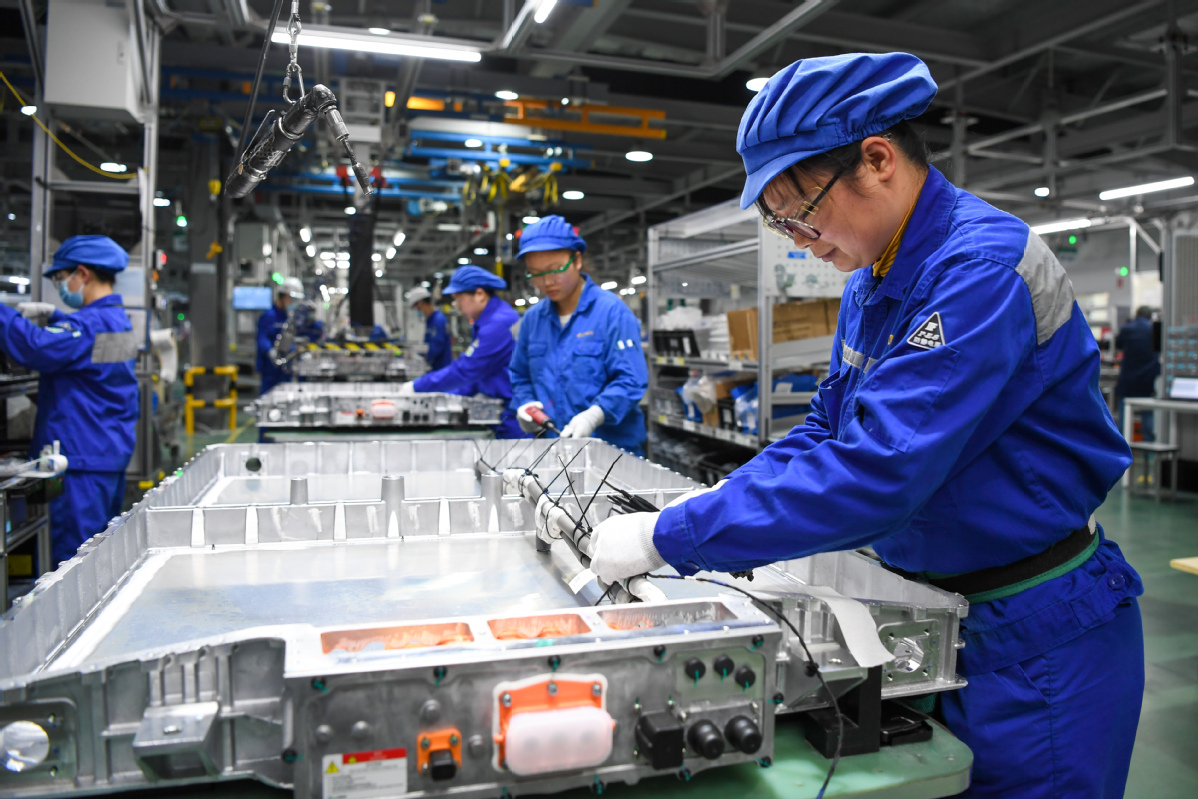Innovation opens new doors for country's exports
Cutting-edge technologies, sustainable solutions move to forefront over conventional goods


To offer companies more export options and minimize risks, the State Council, China's Cabinet, announced a series of measures early last month to accelerate integrated development of domestic and foreign trade. The aim is to simplify regulations and remove obstacles for businesses to access domestic and foreign markets.
The government will ease the alignment and integration of trade regulations between domestic market-oriented companies and export-oriented businesses, promote the coordination of domestic and international trade standards, inspection and certification, as well as regulatory systems, to continuously meet international standards.
Yantai Tiezhongbao Steel Processing Co, another maritime equipment manufacturer based in Yantai, found that its original growth model focused on domestic trade no longer met its needs. As a result, it is seeking processing and trading orders in overseas markets.
Qu Xiaoqun, the company's vice-president, said, "Even though we have exported a few components for offshore drilling platforms and specialized vessels in recent years, we found that it wasn't easy when we tried to independently engage in foreign trade."
The company decided to adopt a processing and trading approach. This involved importing steel alloy plates and transforming them into versatile guidance structures for use on oil pipelines and maritime equipment. These finished products are then exported to energy companies based in Qatar, France and Norway.
Recovery expected
Customs data show that China's foreign trade amounted to 37.96 trillion yuan from January to November, consistent with the corresponding period for the previous year.
Zhong Zhengsheng, chief economist at Ping An Securities, said the economic resilience of the US and Europe last year was primarily driven by a recovery in the service sector, while manufacturing and commodity demand remained lackluster. This had a dampening effect on China's export performance.
There is hope for the synchronization and improvement of the manufacturing cycles in China, the US, and globally next year, Zhong said, adding that thanks to the recovery in global manufacturing and commodity trade, the general direction for China's export recovery and growth appears more certain.
"While there may be some pressure due to adjustments in the global industrial supply chain, which could affect China's export regions and their products' market occupancy abroad, the overall impact on the country's total volume of exports should not be overly concerning," he said. "We anticipate that in 2024, China's exports will experience a modest recovery, with export growth expected to reach up to 4 percent on a yearly basis."
Liu Xiangdong, a researcher at the China Center for International Economic Exchanges, which is based in Beijing, stressed the importance of diversifying export markets to reduce dependence on any single market and mitigate the effects of sluggish external demand. China should actively explore emerging markets and regions with growing consumption power, Liu said.
By expanding market access and promoting trade cooperation with these economies, Chinese exporters can tap new opportunities brought by the Regional Comprehensive Economic Partnership, the Belt and Road Initiative, the nation's pilot free trade zones, and the annual China International Import Expo to offset the decline in traditional markets, Liu added.
The use of digital technologies and e-commerce platforms is likely to help Chinese exporters adapt to changing market situations to expand their presence worldwide. This approach also opens up new avenues for accessing international markets and overcoming logistical challenges, Liu said.
To create effective drivers for China's foreign trade, the Ministry of Commerce said last month it would help the nation's exporters establish overseas warehouses for cross-border e-commerce, offer tailored training on new foreign trade formats to interested businesses, and encourage innovations in cross-border e-commerce.
China's imports and exports via cross-border e-commerce stood at 1.7 trillion yuan in the first three quarters of last year, up by 14.4 percent year-on-year, the ministry said.
Xu Hongcai, deputy director of the China Association of Policy Science's economic policy committee, said the increasing importance of emerging economies in bolstering China's exports is undeniable. However, there is still a lack of supporting services for businesses venturing into these markets.
"Expanding the scope of export credit insurance is critical, as it enables the expansion of credit assistance for companies engaged in exports to emerging markets," Xu said, adding that it is equally essential to encourage financial institutions to play a better role in advancing cross-border services, and facilitating investment and financing. This is particularly vital in sectors such as cross-border e-commerce and market procurement, where dedicated efforts should be made.
Apart from encouraging domestic companies to take part in international exhibitions and trade events, the government should provide comprehensive information services for exporters. This includes offering legal and regulatory information on areas such as land, environmental protection, and wages in overseas markets, Xu added.
In late October, the GAC introduced 16 reform measures to improve the quality of processing trade and provide stronger policy support for the industry's gradual evolution. Processing trade involves importing raw materials or components and exporting them as finished products after they are processed or assembled on the Chinese mainland.
Huang Lingli, deputy director of the GAC's commodity inspection department, said the policies are aimed at encouraging imports of key commodities such as crude oil, coal, natural gas, iron ore, copper concentrate, and grains.
The manufacturing facilities are located in central, western, and northeastern areas of China, and the initiative is designed to boost local processing trade activities to stabilize the supply and industrial chains of strategic commodities, Huang said.
Last month, Tang Wenhong, assistant minister of commerce, said at an economic forum held in Beijing by the China Center for International Economic Exchanges that for its next step, the government will introduce a number of innovative and comprehensive measures in areas such as trade, investment, finance, and other sectors to further advance its opening-up process.
Contact the writers at zhongnan@chinadaily.com.cn


















